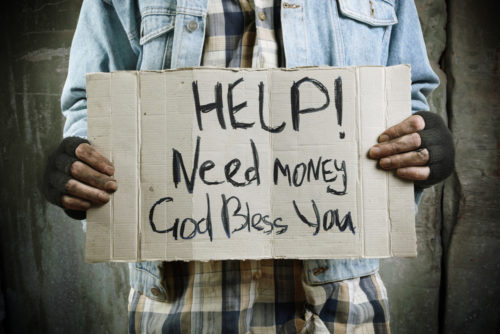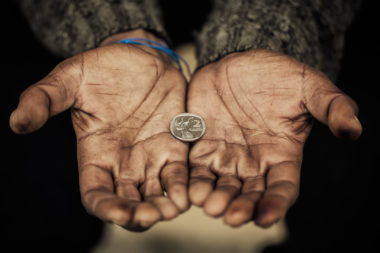As of 2017, about 39.7 million people live in poverty across the United States. This is according to a study produced by the US Census Bureau that looks at overall average (mean) income for households across the country. This makes up only about 11-12 percent of the population, and it is not an uncommon issue even for relatively rich countries.
Do Some People Deserve to be Poor?
A 2014 study by Pew Research on the subject of “getting ahead in life” revealed that about 73 percent of Americans believed that hard work was key, whereas only 18 percent believed that coming from a rich family was most important. Unfortunately, this reflects a common assumption in America that poverty is something that only affects people that are lazy, overspend on vices like drugs or alcohol, overeat, and waste away their days watching television. Hard work is viewed as incompatible with poverty.
The reality is often more complex than popular opinion allows for. Poverty can come in many forms — from sudden loss of money, to lack of income due to health issues, to generational disparities caused by low wages, barriers to homeownership, and other institutionalized limitations placed on marginalized individuals. There are many reasons why a person may be struggling within poverty, and there’s no one story that fits every person.
However, this cultural stigma against poverty still exists today, and may exist for some time. Yet, if you’ve always wondered why it is that poor people have such a difficult time breaking the cycle of poverty — or even wondered what exactly the “poverty cycle” means — then you may be beginning to understand that many of those cultural ideas are misinformed. How exactly do individuals become impoverished, how does the cycle of poverty effect different people, and how can poverty be generational? Can the cycle of poverty be broken, and what would it take in order to break free? Let’s find out.
Table of Contents
The Poverty Cycle: Why Poor People Stay Poor
Poverty is entirely based off of capital, or the financial assets of a person. This can include physical property (homes, land, a business, etc), a person’s education and employment history, a person’s creative ideas and creative licenses (intellectual capital), a person’s network of relationships (social capital), and a person’s overall culture (style of speech, way of dressing, education level, etc) (cultural capital).
Without significant capital in any of these categories, a person can become impoverished. Since our society is heavily stratified by socioeconomic categories (just think about low income, middle class income, and high income, as well as the many other variations of socioeconomics), all these forms of capital are of the utmost importance in order to progress through society and change one’s status.
Inherited and Generational Poverty
The cycle of poverty is defined as a set of factors or events that lead to poverty, and, once started, will continue to create impoverished circumstances unless there is outside intervention. That outside intervention could come as a sudden financial windfall — such as winning the lottery, an inheritance from an estranged relative, or some other fortunate receipt. Or it could come as a change in circumstances — such as moving and starting a new job, getting a diploma that elevates your career, or some other similar situation that leads to increased income.
However, it’s important to note that the cycle of poverty often includes multiple generations of people. In general, the poverty cycle has to go back at least three generations for it to become generational, because only then has enough time passed to eliminate any potential past relatives that may possess and can potentially transmit the intellectual, social, and cultural capital necessary to stay out of or change their impoverished condition. Without the potential for an inheritance of any sort, the individuals living now have to rely on other means in order to break the cycle of poverty.
However, there are other factors at play — all of which require some form of access to money. Let’s dive into each aspect of what makes poverty into a cycle.
Limited Education
Education can be a major barrier to breaking the cycle of poverty, and although the US offers free public education to every child, there are still many children and schools that lack funding and an appropriate support system. Additionally, outside learning opportunities — such as purchasing books, technology, tutoring, or extracurricular activities — may be completely out of reach for children living in poverty.
Dilapidated School Infrastructure
Especially in highly impoverished areas, local taxes don’t provide a lot of funding to support the school system, and some children may have overcrowded classrooms, little to no free school lunches, and negative or damaging interactions with teachers and law enforcement officials. These schools also often lack proper school supplies, seating, heating or cooling, and other essentials that could benefit the learning environment.
Health, Shelter, and the Long-term Effects of Mental Wellbeing on Learning
Health and learning, in particular, are closely interrelated. Many children living in poverty do not have access to healthy foods or struggle with malnutrition, which can further limit their abilities to learn and retain information. They may also be less likely to see a doctor and may suffer from childhood diseases without proper treatment. On top of all this, many children in poverty struggle with mental health issues, poor self-esteem, and a lack of motivation to complete school due to their circumstances and health.
Shelter is another issue affecting young students, as some poor families may not have access to stable housing. They may be forced to move from town to town in order to find work or move in with family, and many children in these environments have to also switch schools whenever they move. The constant changing environments almost always have a negative effect on learning and social abilities.
In all, these kids may struggle to finish school, and many will not have the grades nor the desire to pursue postsecondary education. Although more people than ever before hold a four year college degree in the US, many of the children who were raised in poverty will not go on to pursue a college degree, themselves, or may struggle to complete one due to the overall cost of higher education. Unfortunately, this may leave them out of the majority of high paying jobs that will open up in the next few years — many of which require a four year degree or more — and they may further fall into the poverty cycle.
Limited Employment Opportunities
Limited education also leads to limited employment opportunities, but there are many reasons why a person may lack employment experience. Here are some common scenarios:
- They don’t have the educational background to really pursue new career paths and many jobs may be out of their reach.
- They could have limited connections outside of their community, making finding a job in a new city with more opportunities nearly impossible.
- They could be suffering from a disability, and unable to hold down a job due to their health.
- They could also simply be too risk-averse, which is common behavior amongst the poorest populations. When people have less money, they’re less likely to partake in potentially risky financial situations that could damage or limit their already tight income. Switching jobs can be risky, especially when many jobs have a probationary period: limiting access to health benefits, and offering less flexibility to new employees.
- The job they have right now is just enough to pay the bills, but isn’t enough to elevate them out of poverty.
- There are many areas of the country where good-paying jobs are nearly impossible to find.
- There are also those that are simply trying to survive. For many of those suffering from homelessness, getting a job may help them, but it’s not their first priority. They also need access to food, shelter, and clean water — all of which may be hard to find. Until these most basic needs are met, finding a job often has to be put on hold.
Family Structure and Home Environment
The development on a child is a mixture of nature and nurture. Genetics certainly play a part in how children learn and grow, but their physical environment, role models, nutrition, and a host of other factors can all influence how that child develops over their lifetime.
Poverty can certainly have a negative effect on a child’s ability to learn — limiting their exposure to learning opportunities and their access to healthy foods — but the home environment and family structure are also important aspects of development. In unstable home environments, or those that were struggling with poverty and the stress of not having money, many children in these situations are also stressed, which can further hamper development.
Impoverished Homes Impair Development
A comprehensive study performed in 1994 compared the “associations between child well-being and household stressors, family characteristics, and participation in enrichment activities.” Through this research, they found that children living in poverty have many barriers to succeeding in academics. Overall, about 67 percent of children living below the poverty line were “on track” in academics, whereas about 81 percent of those living well above the poverty line (300 percent and above) were “on track” in academics.
Additionally, factors such as the parent’s educational level (college or no college) and location both had an effect on childhood development. Parents that had a college education were more likely to have children that were succeeding academically. In turn, children living in the suburbs (instead of heavy metropolitan areas) were more likely to be on track with academics. Single parents are also more likely to experience poverty, as their income is more limited than if they shared it with a married partner. Single mothers, specifically, are more likely to experience poverty than single fathers, and children in these families often have poorer educational outcomes.
Another interesting revelation that the study found is that: “Children who are living in housing that is not owned by their family are significantly less likely to also be on-track.”
Overall, researchers found that: “Of the covariates included, measures of household and individual stress proved to have the most persistent relationship with current child well-being as measured by the child’s current grade and age.”
Health Challenges
The World Health Organization (WHO) recognizes that those living in poverty are often surrounded by unsafe environments, either lacking in adequate shelter, access to clean water, or proper sanitation.
Hazardous Environments
For some in poverty, their homes may be located near hazardous materials, or they may not have proper ventilation, heating, and cooling within the home. They may also have water that is full of chemicals and rust, as the area of town that they live in may be lacking in proper or updated infrastructure. For example, in Flint, Michigan, many of the pipes throughout the town were made of lead or iron, corroded due to improper water treatment, and caused increasing cases of lead poisoning among the local citizens.
The Rising Cost of Healthcare
However, the environment is only one part of the health crisis affecting those living in poverty. Healthcare is expensive, especially in the United States. Private health insurance is often provided by employers for full time workers, but still can cost additional money. And although Medicaid is available to those without health insurance coverage, several states do not offer Medicaid coverage for those living below the poverty line. Unfortunately for many Americans living in poverty, health insurance may be unobtainable.
Because of this, seeking out healthcare can be an especially expensive endeavor. Some people may feel it’s better to treat their conditions at home, avoiding the doctor altogether, and potentially even worsening their conditions. For those with a chronic illness, avoiding the doctor can be detrimental and potentially deadly — causing their condition to get progressively worse until they absolutely need medical attention. Any medical bills that they do collect may end up going unpaid, causing families to have to file for bankruptcy, while potentially ruining their credit scores.
Other Health Challenges
And, again, access to healthy food is a major issue that affects the overall health of adults and children living in poverty. Without access to affordable healthcare, clean water, or healthy foods, the health of many of those living in poverty is nearly always at risk — which then further cycles back into increased stress, decreased learning capabilities, and further limiting their income due to expensive medical bills and increased risk of disease.
Access to Credit and Financial Resources
Oddly enough, it can be very expensive to be poor. Although it might seem oxymoronic, there are simply too many predatory practices in the financial world that can profit off of the poor and destitute.
Predatory Lenders and Bank Fees
Predatory lenders such as payday loans or “rent to own” services can provide people in poverty with easy access to near-instant money and services without a credit check, but then end up costing considerably more in the long term. Payday loans, in particular, can have exorbitantly high interest rates — some as high as 300-400 percent.
Additionally, many banks have overdraft fees of $35-$40 — which may not seem like much, but can be devastating to those living on a fixed or meager income. Paying bills can be risky if they’re close to overdrafting, which in turn can affect their credit score if they pay their bills late and their access to additional financial services. As one article in the Economist noted: “Some 8 percent of American households—and nearly one in three whose income is less than $15,000 a year—do not [have a bank account]. More than half of this group say banking is too expensive for them. Many cannot maintain the minimum balance necessary to avoid monthly fees; for others, the risk of being walloped with unexpected fees looms too large.”
Credit Score Challenges
Medical debts are another reason why many people in poverty are struggling with increasing their credit scores. Although some updates to credit reporting eliminate medical collections debt, many banks still rely on old credit scoring models. With such large bills that appear as “delinquent” on their credit report, it’s nearly impossible for those living in poverty to prove themselves worthy of a loan to lenders or banks.
There are many other reasons why a person in poverty may be struggling financially — inability to pay child support or credit card bills, high interest rates on loans or credit accounts, abundant student loan debt if they went to college, and more — and all of it can mount up to nearly impossible financial hurdles to overcome. Budgeting, in general, is nearly impossible with such a tight income. In turn, their credit scores may plummet, further limiting their access to financial services that may help them.
Growing Up Poor
All of the factors listed above can have a massive effect on the growth and development of a child. Unlike people who are born into a middle class family — with their parents owning a home (land), having a steady income, and having access to healthy food and clean water — poor families often struggle to get even their most basic needs met. They most likely don’t own a home, don’t have access to healthy food or clean water, and may not be able to provide a steady income that can support a child while they attend public school.
For this reason (as well as additional barriers, such as racism, ableism, or sexism), these children are set up with a severe disadvantage to being able to earn money and break the cycle of poverty. In addition, whereas other families might be able to secure some future financial stability for their children by offering an inheritance, many poor children don’t have that reassurance.
Additionally, these children may grow up to have an unhealthy relationship with money. Financial concerns caused severe stress for their parents, and the next generation of children born into poverty will internalize that stress that their parents projected. They may even have a limited knowledge of how to balance a checkbook, how to budget their finances, and how to utilize social services that can help them in their time of need. Overall, growing up poor can create another generation that is unable to break the cycle of poverty due to mental limitations, physical health issues, limited experience with finances and education, and a lack of overall social, intellectual, and cultural capital.
Breaking the Cycle of Poverty
It can be discouraging to see all the different aspects that go into the cycle of poverty. It truly is a vicious cycle, so how can anyone break out of it and overcome it? Luckily, there are some ways to do it, but it takes time, dedication, and sometimes taking bigger financial risks than many people in poverty may not be willing to make.
Education
Many believe that education is the key to breaking the cycle of poverty. It is true that a college degree and a solid educational background can help elevate people through increased job opportunities and increased pay. However, many of the problems apparent in the public education system today have to do with severe budget cuts, overworked and underpaid teachers, and overcrowded classrooms. Unfortunately, government changes are what are needed most in order to improve educational opportunities for everyone — not just those living in poverty.
Public Policy
Governmental changes are also needed within the public sector in order to create more accessible pathways for those living in poverty. Many large cities criminalize homelessness, which further stigmatizes those in poverty, and creates additional barriers — not to mention costing the city, those arrested, and local community thousands of dollars in taxes and incarceration costs. Of the many social programs that are created to help those in poverty, many local governments turn to those programs first when they need to make budget cuts.
Self-Help
Unfortunate stigmas surround social services, but these services were created for the sole reason of helping those stuck in a dire situation. If you find yourself struggling to make ends meet, relying on resources such as food stamps (also known as SNAP), Medicaid, or Social Security Disability Insurance (SSDI) does not mean you are a lazy or entitled person. These services can help you gain access to healthy foods, health care, and some additional income assistance.
Additionally, if you do need medical help, there are some free and sliding scale clinics located across the country that may be able to help you despite your income limitations.
Community
Finally, one of the most important aspects of overall health and wellbeing is having a strong and supportive network or community of people. If you find yourself facing some dire situations, having a support system can help you make it through — whether by providing emotional or mental support, or by providing you with additional money to help you pay the bills. Just like how food, shelter, and clean water are some of the most basic human needs, so is community and our connection to each other. If you’re lucky, you may be able to break the cycle of poverty over time, and may be able to eventually pay it back to those that helped you in your time of need.
Poverty can be a vicious cycle, and there are many different variables that go into this economic status. Unfortunately, there’s also many social beliefs and governmental policies that may be working against you, but there are ways to elevate yourself — and future generations — out of poverty through time, dedication, the help of social services and your community, and education.
Image Source: https://depositphotos.com/





